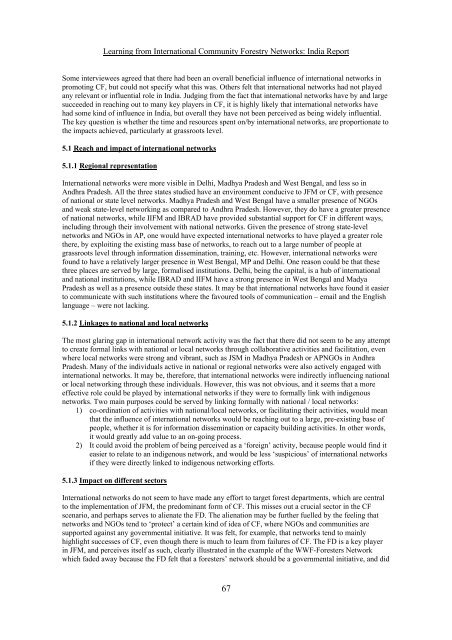Snapshots of International Community Forestry Networks: Country ...
Snapshots of International Community Forestry Networks: Country ...
Snapshots of International Community Forestry Networks: Country ...
Create successful ePaper yourself
Turn your PDF publications into a flip-book with our unique Google optimized e-Paper software.
Learning from <strong>International</strong> <strong>Community</strong> <strong>Forestry</strong> <strong>Networks</strong>: India Report<br />
Some interviewees agreed that there had been an overall beneficial influence <strong>of</strong> international networks in<br />
promoting CF, but could not specify what this was. Others felt that international networks had not played<br />
any relevant or influential role in India. Judging from the fact that international networks have by and large<br />
succeeded in reaching out to many key players in CF, it is highly likely that international networks have<br />
had some kind <strong>of</strong> influence in India, but overall they have not been perceived as being widely influential.<br />
The key question is whether the time and resources spent on/by international networks, are proportionate to<br />
the impacts achieved, particularly at grassroots level.<br />
5.1 Reach and impact <strong>of</strong> international networks<br />
5.1.1 Regional representation<br />
<strong>International</strong> networks were more visible in Delhi, Madhya Pradesh and West Bengal, and less so in<br />
Andhra Pradesh. All the three states studied have an environment conducive to JFM or CF, with presence<br />
<strong>of</strong> national or state level networks. Madhya Pradesh and West Bengal have a smaller presence <strong>of</strong> NGOs<br />
and weak state-level networking as compared to Andhra Pradesh. However, they do have a greater presence<br />
<strong>of</strong> national networks, while IIFM and IBRAD have provided substantial support for CF in different ways,<br />
including through their involvement with national networks. Given the presence <strong>of</strong> strong state-level<br />
networks and NGOs in AP, one would have expected international networks to have played a greater role<br />
there, by exploiting the existing mass base <strong>of</strong> networks, to reach out to a large number <strong>of</strong> people at<br />
grassroots level through information dissemination, training, etc. However, international networks were<br />
found to have a relatively larger presence in West Bengal, MP and Delhi. One reason could be that these<br />
three places are served by large, formalised institutions. Delhi, being the capital, is a hub <strong>of</strong> international<br />
and national institutions, while IBRAD and IIFM have a strong presence in West Bengal and Madya<br />
Pradesh as well as a presence outside these states. It may be that international networks have found it easier<br />
to communicate with such institutions where the favoured tools <strong>of</strong> communication – email and the English<br />
language – were not lacking.<br />
5.1.2 Linkages to national and local networks<br />
The most glaring gap in international network activity was the fact that there did not seem to be any attempt<br />
to create formal links with national or local networks through collaborative activities and facilitation, even<br />
where local networks were strong and vibrant, such as JSM in Madhya Pradesh or APNGOs in Andhra<br />
Pradesh. Many <strong>of</strong> the individuals active in national or regional networks were also actively engaged with<br />
international networks. It may be, therefore, that international networks were indirectly influencing national<br />
or local networking through these individuals. However, this was not obvious, and it seems that a more<br />
effective role could be played by international networks if they were to formally link with indigenous<br />
networks. Two main purposes could be served by linking formally with national / local networks:<br />
1) co-ordination <strong>of</strong> activities with national/local networks, or facilitating their activities, would mean<br />
that the influence <strong>of</strong> international networks would be reaching out to a large, pre-existing base <strong>of</strong><br />
people, whether it is for information dissemination or capacity building activities. In other words,<br />
it would greatly add value to an on-going process.<br />
2) It could avoid the problem <strong>of</strong> being perceived as a ‘foreign’ activity, because people would find it<br />
easier to relate to an indigenous network, and would be less ‘suspicious’ <strong>of</strong> international networks<br />
if they were directly linked to indigenous networking efforts.<br />
5.1.3 Impact on different sectors<br />
<strong>International</strong> networks do not seem to have made any effort to target forest departments, which are central<br />
to the implementation <strong>of</strong> JFM, the predominant form <strong>of</strong> CF. This misses out a crucial sector in the CF<br />
scenario, and perhaps serves to alienate the FD. The alienation may be further fuelled by the feeling that<br />
networks and NGOs tend to ‘protect’ a certain kind <strong>of</strong> idea <strong>of</strong> CF, where NGOs and communities are<br />
supported against any governmental initiative. It was felt, for example, that networks tend to mainly<br />
highlight successes <strong>of</strong> CF, even though there is much to learn from failures <strong>of</strong> CF. The FD is a key player<br />
in JFM, and perceives itself as such, clearly illustrated in the example <strong>of</strong> the WWF-Foresters Network<br />
which faded away because the FD felt that a foresters’ network should be a governmental initiative, and did<br />
67

















![CynefinFramework final [Read-Only]](https://img.yumpu.com/19017304/1/190x135/cynefinframework-final-read-only.jpg?quality=85)